Kitten Nora and the Phase of Defiance!
(My editor was right on both counts! Unfortunately, Heute hab ich WUT IM BAUCH! by Anna Böhm (Oetinger, 2021) is currently only available in German.)
Most pre-schoolers feel things intensely – and the book’s main character, an endearing little kitten, named Nora, is no exception!
We put it down to ‘the terrible twos’ here in the UK. In Germany, they call this the ‘Trotzphase’. Literally, the phase of defiance.
Oetinger’s goal was to create a fun picture book that would help little ones and their parents to get through this tricky stage. From that point of view, Heute hab ich WUT IM BAUCH! (which translates as Today I have ANGER IN MY STOMACH! but sounds rather gripping as Kitten Nora and the Phase of Defiance!) is successful.
I’ve illustrated this theme before, notably NO! by Tracey Corderoy (featuring the adorable Archie). Depicting such intense emotions in cute characters is great fun. I grew up reading comics (I still read them today) and welcome the opportunity to channel their visual language into my own work.
Here’s Archie, freaking out in Indonesian!

Remember Max, the wolf-suited boy from Where The Wild Things Are? He paved the way for picture books characters like Nora and Archie. (Sendak describes Wild Things as beginning ‘with a child in rage.’)
Published in 1963, it was radically different from picture books that came before and marked a change in how they depicted children (since it confronted ‘negative’ childhood emotions head-on). Equally groundbreaking, Wild Things wasn’t created to modify a child’s behaviour by modelling sugar and spice and all things nice. Max and his Wild Things opened wide the gates for picture books that depict kids’ emotions and experiences as they are, warts and all.
“We are squeamish. We are Disney-fied,” bemoaned Sendak. “We don’t want children to suffer. But what do we do about the fact that they do? The trick is to turn that into an art.”
It’s okay to be angry sometimes. But it’s unhealthy to hold on to anger, as this Buddhist saying eloquently teaches:
“Holding on to anger is like grasping a hot coal with the intent of throwing it at someone else — you are the one who gets burned.”
(Paraphrased from the work of Buddhaghosa in Visuddhimagga IX, 23 by James Clear.)
We must teach our kids how to handle their negative emotions and learn ways to calm themselves down. And that’s where Angry Nora comes into its own.
Nora’s day begins well enough. She is bright and cheery and keen to persuade her friend, Pauli, to join her outside.
“We can swing and run around. It’s going to be fun,” Nora calls out.
“Nope,” Pauli says. “I want to draw.” …
“Alright,” says Nora. “Then I’ll draw with you.”
But Pauli is content drawing alone:
“No!” says Pauli. The no sounds very loud…. Oh! That was mean of Pauli.
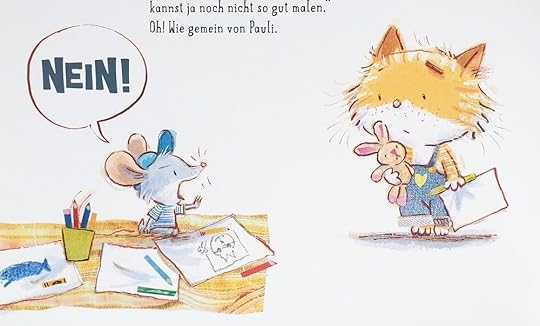
Unable to handle the rejection and her emotions, Nora grabs a pencil and ‘makes a fat dash’ on Pauli’s picture. Uh-oh!
[image error]Eddi, the donkey, is busy in his repair shop. He’ll play later, he tells Nora, just not right now.
[image error]
Later? What’s that supposed to mean?!
Nora gets angry and starts screaming – really loud!
ICH WILL ABER JETZT! BUT I WANT TO NOW!
She stomps off to the kitchen, where Schäfli the sheep is baking a cake.
“Hey there!” says Schäfli. “Would you like some cherries?”
Oh yes, Nora would like that very much! The cherries taste sweet.
Nora’s smile doesn’t last, though.
She climbs onto a shelf, only to be put back down by Schäfli.
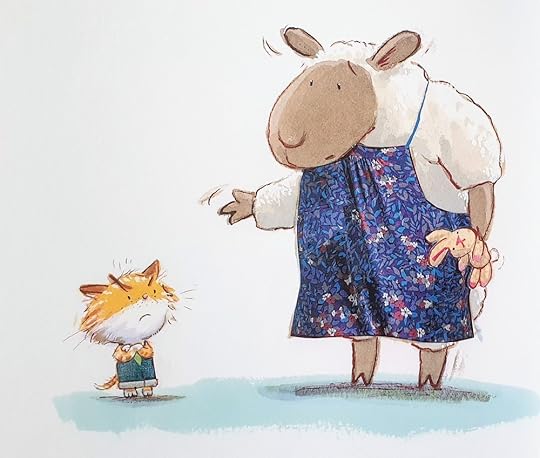
“You’re still too young, Nora. You could fall and hurt yourself.”
Nora knows that she is small! Schäfli doesn’t have to tell her that.
Nora gets angry again. And if you get angry for the third time in a day - well, watch out! Because the anger is powerful.
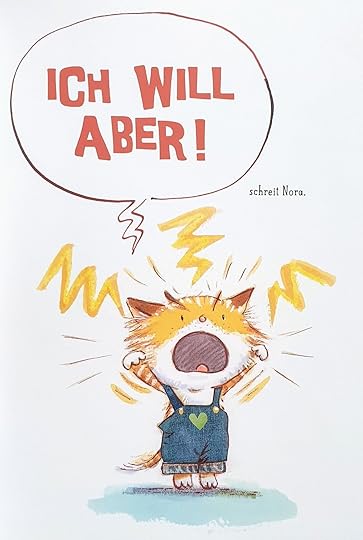
I love how Böhm describes Nora’s all-consuming anger:
Nora will nicht zuhören. Ihre Wut ist jetzt überall. Im Kopf. Im Bauch. In den Füßen. In den Händen. Und weil sie so stark ist, muss sie unbedingt raus.
Nora doesn’t want to listen. Her anger is everywhere now. In her head. Her belly. In her feet and her hands. And because it’s so strong, she absolutely has to get it out.
The more Schäfli tries calming things down, the angrier Nora becomes. Until finally, Schäfli snaps!
“I don’t like it when you yell, Nora,” exclaims Schäfli. “I was just so happy. But you’re ruining my good mood.
She takes Nora outside to calm down. “You can rage here.”
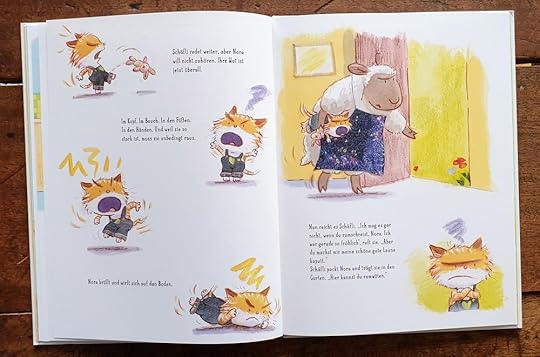
Lollo (an elderly sausage dog) is relaxing in the garden under the cherry tree.
Lollo is like the wise old sage. A peaceful presence.
He can’t help but notice Nora’s tantrum. But he gives her the space she needs.
After a while, he brings Nora some sticks, which she snaps in half.
[image error]It feels good, and some of Nora’s anger leaves her hands.
Lollo nods.
He sits down next to Nora. As she yells, more anger escapes from her mouth. When she jumps and stomps, the anger comes out of her feet.
I love the following line:
Diese Wut ist ein schlimmes Gefühl, aber auch ein schönes, weil sie so stark ist. Und weil sie überall ist.
Anger is a bad feeling, but a nice one, too, because it is so strong. And because it’s everywhere.
It contains so much truth.
Anger is all-consuming and destructive. (‘For anger,’ as Ecclesiastes 7:9 warns, ‘lodges in the heart of fools.’)
But when someone does you wrong, anger can be energising and powerful. People love to feel righteously angry. (And sometimes, that’s appropriate.)
Yep! Anger’s a complicated emotion, alright!
Lollo puts his big paw on Nora’s back. The paw is soft and warm.
He listens then hands Nora more sticks.
Nora breaks them into pieces. Some sticks are longer. Some shorter. Some are crooked. Nora lays out a pattern.
Suddenly she realises that she isn’t yelling anymore.
“Do you get angry, too?” she asks her friend.
“Sure!” says Lollo. “Everyone gets angry sometimes. It’s a part of life. Then I run wildly through the garden and throw things!”
How wise!
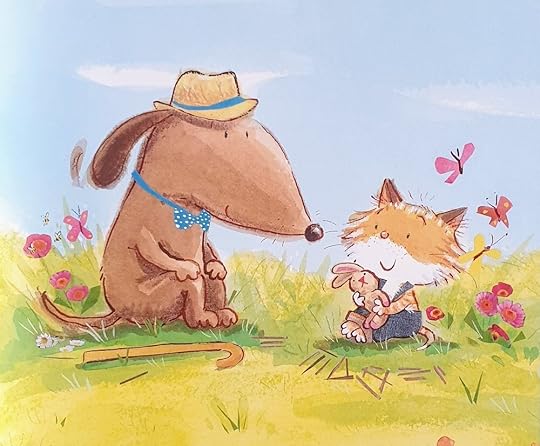
After a mishap with the cake, it’s Shäfli’s turn to explode. (Think, Sheepzilla!)
Fortunately, Kitten Nora is on hand to offer a gentle paw and reassuring words.
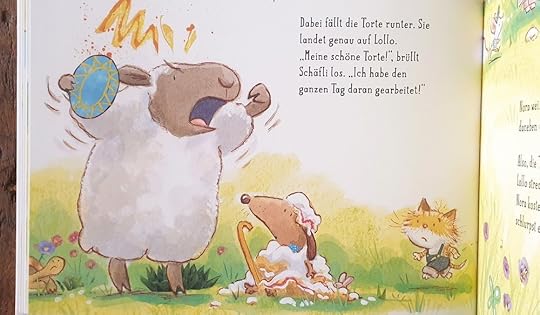
Nora’s the epitome of a wise counsellor – until Lollo pops up from underneath the trashed cake. Then Nora explodes again. Only this time, with laughter.
Quality picture books that tackle difficult emotions are a gift to families.
Nora’s laughter is everywhere! In her head. Her belly. In her feet and her hands. The more she laughs, the stronger and more wonderful the feeling becomes.
Her friends start laughing, too. Even Shäfli’!
“I think I just freaked out, too,” says Sheeply with a giggle.
Nora nodded. “We both did”, she says. “But don’t worry. Everyone gets angry sometimes. It’s a part of life!”
Many address children’s worries and concerns. Others (like ‘Angry Nora’) prompt you to listen attentively to your kids when they have a meltdown. They offer strategies to help families search beneath the unwelcome behaviour for the root cause. But most importantly, they give kids the words to express their feelings which helps them grow and thrive.
If that can be achieved by sharing a laugh over a story with your child, then everyone’s a winner!
Text excerpts © 2021 by Anna Böhm | Illustrations © 2021 by Tim Warnes GOOD TO READFor navigating difficult emotionsNO! by Tracey Corderoy & Tim Warnes
Penguin by Polly Dunbar
A Little Bit Worried by Ciara Gavin & Tim Warnes
The Colour Monster by Anna Llénas
Tiger Lily by Gwen Millward
Me and My Fear by Francesca Sanna
Where the Wild Things Are by Maurice Sendak
Buy these titles from my Bookshop buy uk buy us * I EARN COMMISSION FROM THESE LINKS #AD/AFFPowered by Bookshop.orgSupporting independent bookshopsRELATED ARTICLESSOURCESHeute hab ich WUT IM BAUCH! by Anna Böhm, illustrated by Tim Warnes (Oetinger, 2021)WILD THINGS! Acts of Mischief in Children’s Literature by Betsy Bird, Julie Danielson and Peter D. Sieruta (Candlewick Press, 2014)Fierce Bad Rabbits: The Tales Behind Children’s Picture Books by Clare Pollard (Fig Tree, 2019)Where the Wild Things Are by Maurice Sendak (Harper & Row, 1963) Why don’t more children’s books feature negative emotions? Plus, helpful resources! (bookriot.com, Megan Mabee, 7 February 2022) The ESV® Bible (The Holy Bible, English Standard Version, Good News Publishers, 2021) 3-2-1: On attracting luck, taking risks, and the ineffectiveness of anger (Jamesclear.com, 18 February 2021)© 2022 BY TIM WARNES(UNLESS OTHERWISE ATTRIBUTED)****USE OF THIRD PARTY COPYRIGHTED MATERIAL FALLS UNDER FAIR USE/FAIR DEALING PRACTICE.My Life in Books
For lovers of kid lit, this memoir - My Life in Books - is intended to give you the confidence and encouragement to share your own passion; to help you make lasting connections through kids’ books.
Originally posted at www.timwarnes.com ...more
- Tim Warnes's profile
- 30 followers



